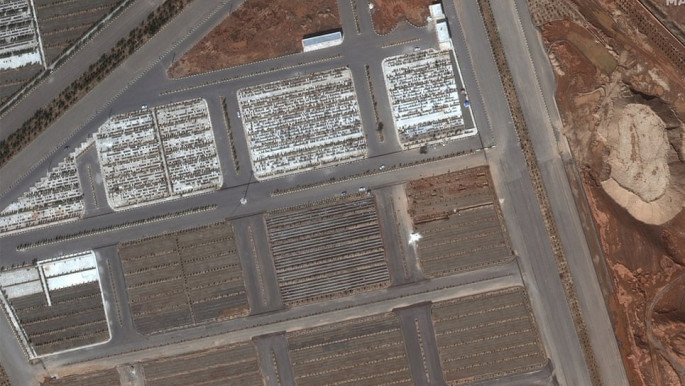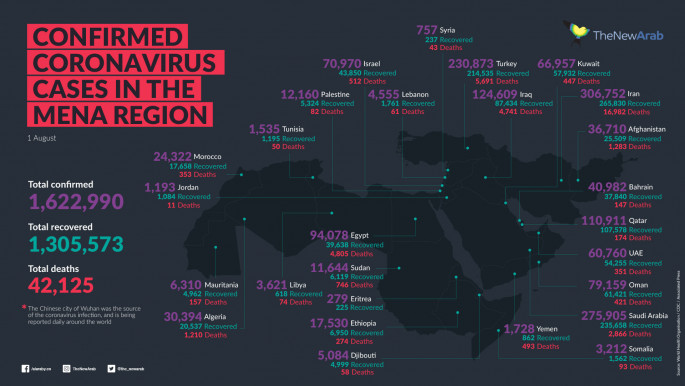Satellite images show mass graves in Qom amid Iran's coronavirus outbreak
The images, revealed by the New York Times on Tuesday, suggest that Iranian workers dug trenches in mass graves in Qom's Behest Masumeh cemetery in February.
According to the latest toll from the health ministry, the coronavirus pandemic has claimed 429 lives in Iran and infected more than 10,000 people.
The outbreak in Iran is one of the deadliest outside China, where the disease originated.
The BBC's Persian-language service, citing unnamed sources in Iran's health system, said at the end of February that at least 210 people had died in the COVID-19 outbreak. Iran's official death toll at the time was below fifty.
Most of the dead were in Qom or in the capital Tehran, the London-based broadcaster said.
 |
|
| Satellite images show Behesht Masoumeh cemetery in Qom [Maxar Technologies] |
"It doesn't surprise me that they are now trying to create mass graves and trying to hide the actual extent of the impact of the disease," Dr Amir Afkhami, an associate professor at George Washington University, told The Guardian.
"Because of China's status as the country's principal commercial partner, the Iranian government took inadequate cautionary measures to restrict and monitor travelers from China," Afkhami said.
"Then, later on, Tehran's lack of transparency and unwillingness to take robust measures such as social distancing and quarantine, particularly at the epicenter of the outbreak, helped spread the virus."
Although many commentators believe Iran is covering up the true scale of the outbreak, some analysts cautioned against interpreting the satellite images without context.
"Islamic customs call for speedy burials, often within 24 hours. Likely tens of people are dying daily due to #COVID19 in Qom, Iran. Two weeks ago, authorities announced they would prepare graves in advance," columnist Esfandyar Batmanghelidj tweeted.
Batmanghelidj pointed to Iranian news reports in which journalists reported the digging of special graves in Behest Masumeh cemetery more than two weeks ago to enable the cemetry to be the "single burial place" for all of Qom's coronavirus victims. This could explain why one location has a high number of graves.
|
Meanwhile, a key adviser to Iran's supreme leader has been placed in quarantine after experiencing "mild symptoms" of the new coronavirus, Tasnim news agency reported on Thursday.
Ali Akbar Velayati, who advises supreme leader Ayatollah Ali Khamenei on foreign policy, was "quarantined after having experienced mild symptoms of coronavirus," the agency said.
It quoted a spokesman at Tehran's Massih Danechvari hospital for its report.
The hospital, of which Velayati, a paediatrician by profession, is the head, is the main centre for coronavirus patients.
"Yesterday (Wednesday) afternoon, when the light symptoms appeared, doctors prescribed a test" for the 74-year-old Velayati, Tasnim said.
Read more: No Nowruz? Iran braces for major changes to New Year celebrations
He was later placed in isolation at his home and given medicine, the agency added without saying whether Velayati had tested positive for the virus.
But Tasnim said that Velayati's "general health is improving".
Velayati is a close adviser to Khamenei and served as Iran's foreign minister from 1981-1997.
Several other politicians, including a vice president, and officials both sitting and former have been infected, with some dying from the illness.
Agencies contributed to this report.
Follow us on Facebook, Twitter and Instagram to stay connected





 Follow the Middle East's top stories in English at The New Arab on Google News
Follow the Middle East's top stories in English at The New Arab on Google News
![Netanyahu furiously denounced the ICC [Getty]](/sites/default/files/styles/image_330x185/public/2024-11/GettyImages-2169352575.jpg?h=199d8c1f&itok=-vRiruf5)
![Both Hamas and the Palestinian Authority welcomed the ICC arrest warrants [Getty]](/sites/default/files/styles/image_330x185/public/2024-11/GettyImages-2178351173.jpg?h=199d8c1f&itok=TV858iVg)
